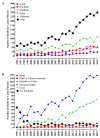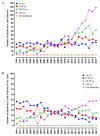Cystic Fibrosis: A Descriptive Analysis of Deaths in a Two-Decade Period in Brazil According to Age, Race, and Sex
- PMID: 36832251
- PMCID: PMC9954801
- DOI: 10.3390/diagnostics13040763
Cystic Fibrosis: A Descriptive Analysis of Deaths in a Two-Decade Period in Brazil According to Age, Race, and Sex
Abstract
The diagnosis of cystic fibrosis has improved in the last few years due to greater access to diagnostic tools and the evolution of molecular biology; the knowledge obtained has contributed to the understanding of its death profile. In this context, an epidemiological study was developed focusing on deaths from cystic fibrosis in Brazil from 1996 to 2019. The data were collected from the Data-SUS (Unified National Health System Information Technology Department from Brazil). The epidemiological analysis included patients' age groups, racial groups, and sex. In our data, between 1996 and 2019, Σ3050 deaths were recorded, totaling a ≅330% increase in the number of deaths resulting from cystic fibrosis. This fact might be related to a better diagnosis of the disease, mainly in patients from racial groups that are not commonly associated with cystic fibrosis, such as Black individuals, Hispanic or Latino (mixed individuals/Pardos) individuals, and American Indians (Indigenous peoples from Brazil). Regarding of race, the Σ of deaths was: nine (0.3%) in the American Indian group, 12 (0.4%) in the Asian group, 99 (3.6%) in the Black or African American group, 787 (28.6%) in the Hispanic or Latino group, and 1843 (67.0%) in the White group. The White group showed the highest prevalence of deaths, and the increase in mortality was ≅150 times in this group, while, in the Hispanic or Latino group, it was ≅75 times. Regarding sex, the numbers and percentage of deaths of both male (N = 1492; 48.9%) and female (N = 1557; 51.1%) patients were seen to be relatively close. As for age groups, the >60-year-old group presented the most significant results, with an increase of ≅60 times in the registered deaths. In conclusion, in Brazil, despite the number of deaths from cystic fibrosis being prevalent in the White group, it increased in all racial groups (Hispanic or Latino, Black or African American, American Indian, or Asian individuals) and was associated with older age.
Keywords: CFTR; diagnosis; distribution per race; epidemiology; genetic screening; human development index; neonatal screening; sweat test.
Conflict of interest statement
The authors declare no conflict of interest.
Figures




Similar articles
-
Racial/Ethnic Disparities in the Performance of Prediction Models for Death by Suicide After Mental Health Visits.JAMA Psychiatry. 2021 Jul 1;78(7):726-734. doi: 10.1001/jamapsychiatry.2021.0493. JAMA Psychiatry. 2021. PMID: 33909019 Free PMC article.
-
Infant and Youth Mortality Trends by Race/Ethnicity and Cause of Death in the United States.JAMA Pediatr. 2018 Dec 1;172(12):e183317. doi: 10.1001/jamapediatrics.2018.3317. Epub 2018 Dec 3. JAMA Pediatr. 2018. PMID: 30285034 Free PMC article.
-
State-specific prevalence of selected health behaviors, by race and ethnicity--Behavioral Risk Factor Surveillance System, 1997.MMWR CDC Surveill Summ. 2000 Mar 24;49(2):1-60. MMWR CDC Surveill Summ. 2000. PMID: 10965781
-
Racial and Ethnic Disparities in Primary Open-Angle Glaucoma Clinical Trials: A Systematic Review and Meta-analysis.JAMA Netw Open. 2021 May 3;4(5):e218348. doi: 10.1001/jamanetworkopen.2021.8348. JAMA Netw Open. 2021. PMID: 34003274 Free PMC article.
-
Disparities in COVID-19 Outcomes by Race, Ethnicity, and Socioeconomic Status: A Systematic-Review and Meta-analysis.JAMA Netw Open. 2021 Nov 1;4(11):e2134147. doi: 10.1001/jamanetworkopen.2021.34147. JAMA Netw Open. 2021. PMID: 34762110 Free PMC article.
Cited by
-
Overview of childhood vaccination coverage in Brazil and the impact of the COVID-19 pandemic: Is our children's health at risk? A review of pre-COVID-19 periods and during the COVID-19 pandemic.Vaccine X. 2024 Jan 9;17:100430. doi: 10.1016/j.jvacx.2024.100430. eCollection 2024 Mar. Vaccine X. 2024. PMID: 38299202 Free PMC article.
-
Were deaths recorded in Brazil due to cystic fibrosis or pulmonary fibrosis? A data-based analysis.Front Med (Lausanne). 2024 Aug 21;11:1459785. doi: 10.3389/fmed.2024.1459785. eCollection 2024. Front Med (Lausanne). 2024. PMID: 39253539 Free PMC article. No abstract available.
-
Epidemiological Profile of Hospitalized Patients with Cystic Fibrosis in Brazil Due to Severe Acute Respiratory Infection during the COVID-19 Pandemic and a Systematic Review of Worldwide COVID-19 in Those with Cystic Fibrosis.Healthcare (Basel). 2023 Jul 4;11(13):1936. doi: 10.3390/healthcare11131936. Healthcare (Basel). 2023. PMID: 37444770 Free PMC article.
-
Impact of CFTR Modulators on Longitudinal Cystic Fibrosis Survival and Mortality: Review and Secondary Analysis.Pulm Ther. 2025 Jul 11. doi: 10.1007/s41030-025-00303-4. Online ahead of print. Pulm Ther. 2025. PMID: 40646419 Review.
References
-
- da Silva Filho L.V.R.F., Maróstica P.J.C., Athanazio R.A., Reis F.J.C., Damaceno N., Paes A.T., Hira A.Y., Schlesinger D., Kok F., Amaral M.D., et al. Extensive CFTR sequencing through NGS in Brazilian individuals with cystic fibrosis: Unravelling regional discrepancies in the country. J. Cyst. Fibros. 2021;20:473–484. doi: 10.1016/j.jcf.2020.08.007. - DOI - PubMed
LinkOut - more resources
Full Text Sources
Research Materials

